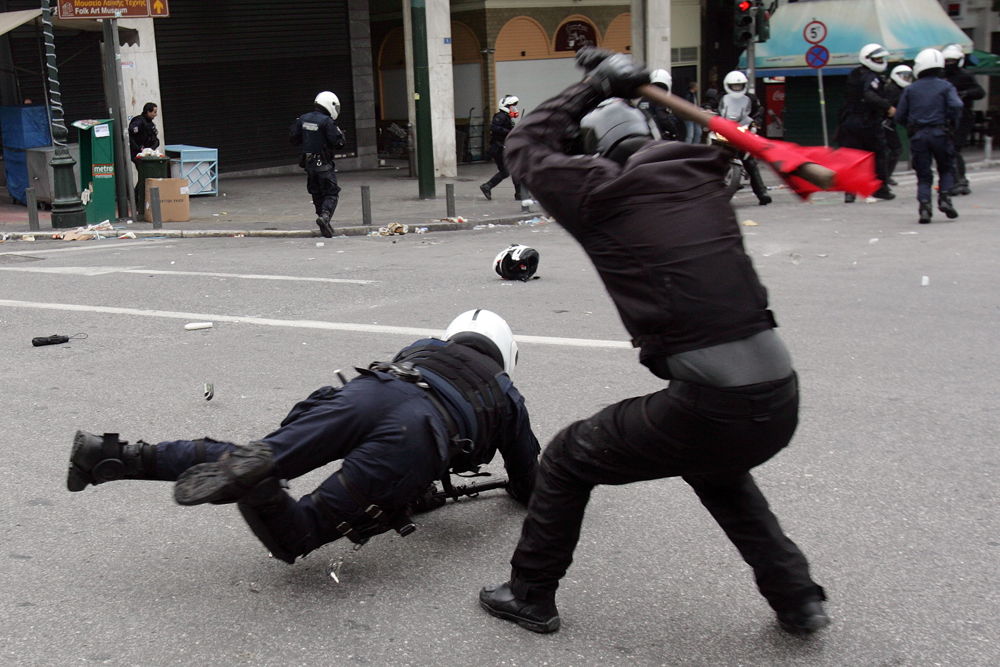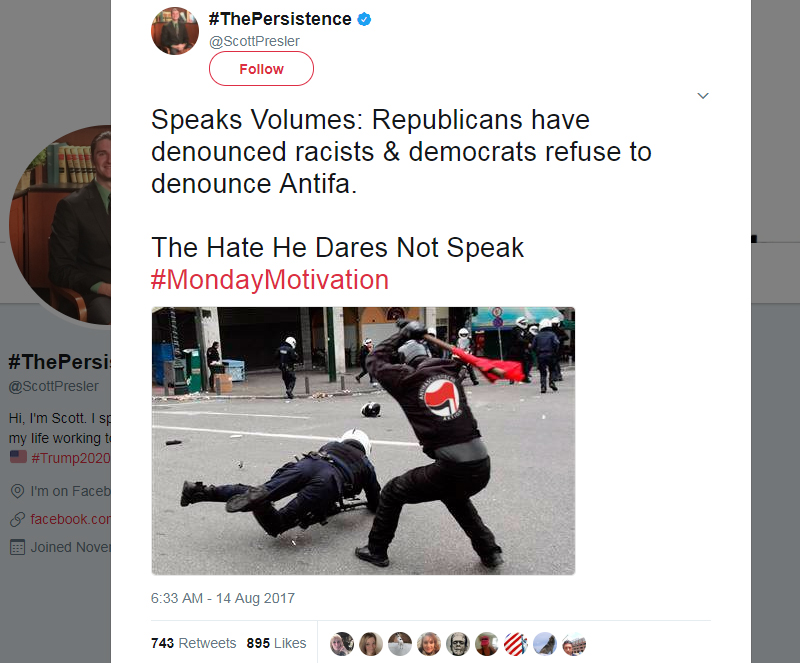A photo that seems to show a man with an Antifa logo on his jacket beating a police officer with a flagpole thick enough to be a club has been around since at least 2010.

The image circulated in the aftermath of rioting in Charlottesville, Va., in social media posts (one now deleted after over 700 retweets) that implied that it had been taken there.
The violence in the image is real enough — it was taken during rioting in Athens in 2009. But the logo on the standing man’s jacket was Photoshopped in, and Greek characters in a sign at upper left were cropped out. (An obviously non-American traffic sign was in an awkward place to crop.)
Here’s the original:

And here’s the doctored version (it’s the highest-quality example we could find):

Weirdly, the earliest example of the doctored image we can find is from a 2010 blog post from the Edinburgh Antifascists, who livened up a Scottish February day by holding a counter-demonstration against the Scottish Defence League. (The post isn’t otherwise all that antagonistic to the police.)
It’s hard to make out the letters on the back of the jacket, but it appears to be the logo of the German antifa group, Antifaschistische Aktion.
WATCH: Hundreds gathered at the University of Virginia campus in Charlottesville on Wednesday night for a candlelight vigil in response to the nationalist rallies over the weekend in the Virginia town.

In fake news news:
- Facebook offers advertisers the ability to micro target ads to specific demographics — car-owning men in their late 20s in Vancouver, for instance. It didn’t take political campaigns long to realize that they could tailor messages very precisely to slices of the voting population, breaking citizens down by sex, age, geography or political leanings. One problem is that the ads (used in Britain and the United States, as far as we’re aware so far) are anything but transparent. If you want to track them, you’re pretty much stuck with crowdsourcing. With a German federal election about a month away, Buzzfeed is asking its German readers to download a Facebook extension that tracks and tries to understand political ads (the story is in German, but Chrome will translate.)
- The Guardian looks at the role of YouTube in right-wing radicalization: “YouTube has in recent years become one of the most influential and powerful social media sites for … far-right and “alt-right” leaders, who have built large audiences outside of mainstream channels.”
- The New Yorker reflects on ‘We’re Coming For You New York Times,’ the sinister video the National Rifle Association published in April. Michael Luo argues that the group’s narrative needs enemies, and after Donald Trump’s election they’ve run short. “Gun owners, contemplating whether to re-up their forty-dollar annual memberships or hand over their credit cards for the first time, might consider the fact that they’re being manipulated,” he writes.
- The Daily Stormer, a sinister white supremacist site which is literally named after a Nazi newspaper, found itself orphaned after last week’s riots in Charlottesville, Va. On Sunday, GoDaddy refused to host them any more, whereupon they tried to get Google to host them. That had a swift and predictable result. The site owners then tried to host it in Russia as dailystormer.ru, but that lasted about a day.
- Foreign Policy‘s story Thursday about how fake news spreads on closed messaging services like WhatsApp was vindicated more or less immediately after the Barcelona terror attack when Spanish authorities warned of fake news about the attack spread on the platform. (Context in English at Buzzfeed.) The problem is that fake reports on messaging services, unlike the public Internet, can fly under the radar un-debunked.
- The Atlantic Council’s Digital Forensic Research Lab delves into an incident last weekend in which a fake-news story purporting to be an interview with a former head of MI6 also purported to be in the Guardian, copying that site’s design, typeface, logo and so forth. The URL, theguardıan.com, looked legitimate at first glance (the “ı” is a character in Turkish). Oddly the content of the story itself wasn’t up to the same standard, and would have immediately raised flags for an English speaker. Buzzfeed suggests it may have been intended for a Russian audience.
- DFRLab also traces how far-right sites in the U.S. took their talking points on Charlottesville from Moscow.
- Norway’s public broadcaster recently brought in a system where readers had to pass a basic quiz about a story before being allowed to comment on it. Five months later, they’ve learned two things: 1) readers do really badly, with a 72 per cent failure rate, and 2) many people seem to just take the quiz for the sake of taking the quiz. More readers pass the quiz than actually end up commenting.
- Wired puts Russian ‘active measures,’ which includes fake news, but can also involve hacked electrical grids and critics ending up dead, in a long historical context, rooted in Soviet and czarist ideas about Russia’s place in the world. “While the operations against the 2016 election caught many in the U.S. by surprise … Russia’s leadership simply sees it as the latest chapter in a long-running shadow battle.” A long read, worth your time.
- AJ+, an Al Jazeera site, talks to a German artist who spray-painted copies of offensive tweets on the sidewalk outside Twitter’s German headquarters in an effort to get them to crack down.


Comments